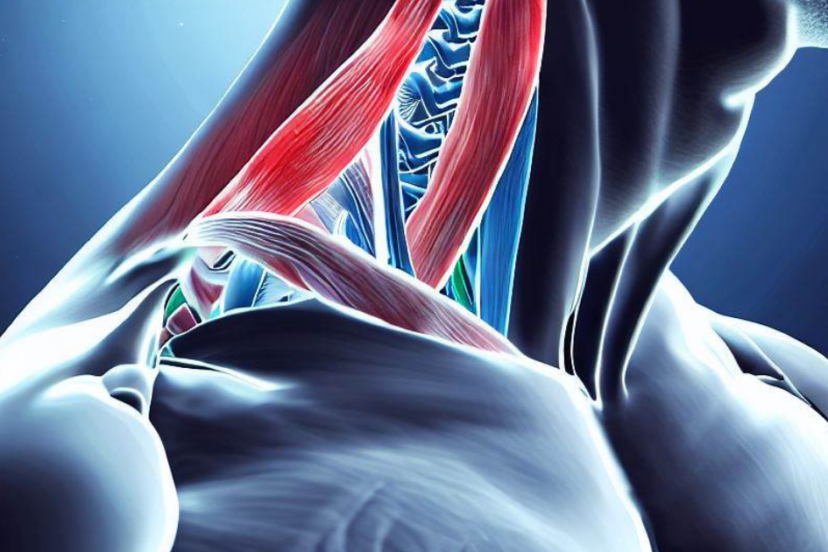Are you looking to improve your posture, alleviate neck pain, and enhance the stability of your neck? If so, then understanding the importance of deep neck flexors and incorporating specific exercises into your routine can make a significant difference. In this article, as an enthusiast and advisor, I will guide you through the world of deep neck flexors, their role in neck health, and provide helpful suggestions to strengthen these crucial muscles.
Maintaining a Strong & Healthy Neck
Maintaining a strong and healthy neck is essential for overall well-being. The deep neck flexor muscles, located deep within the neck, play a pivotal role in providing stability, supporting good posture, and enabling smooth neck movements. Unfortunately, these muscles are often neglected and weaken over time due to poor posture, sedentary lifestyles, or improper neck positioning during activities like working on computers or using smartphones. By understanding these and being able to strengthen them can help to avoid sudden neck
kinks.Understanding the Importance of Deep Neck Flexors
The Role of Deep Neck Flexors in Posture and Stability
Good posture is not just about standing or sitting up straight; it also involves having optimal alignment and balance in various positions. The deep neck flexors, such as the longus colli and longus capitis muscles, work together to maintain proper alignment of the cervical spine and support the weight of the head. They counterbalance the pull of other neck muscles and help resist the effects of gravity.
Common Issues and Symptoms Related to Weak Deep Neck Flexors
Weak deep neck flexors can lead to several issues, including:
1. Forward head posture: The head juts forward, straining the neck and upper back.
2. Rounded shoulders: The shoulders roll forward, contributing to poor posture.
3. Neck and upper back pain: Weak muscles can result in strain and discomfort.
4. Reduced range of motion: Limited ability to move the neck freely.
Strengthening Exercises for Deep Neck Flexors
Exercise has been
clinically proven to help target and strengthen your deep neck flexors, incorporate the following exercises into your routine:
Exercise 1: Chin Tucks
1. Sit or stand with your spine straight and shoulders relaxed.
2. Gently retract your chin, drawing it back towards your neck.
3. Hold the position for 5 seconds, feeling the stretch in the back of your neck.
4. Repeat for 10-15 repetitions.
Exercise 2: Neck Retraction
1. Start in a seated or standing position with good posture.
2. Keeping your eyes forward, gently pull your head back, as if creating a double chin.
3. Hold for 5-10 seconds and release.
4. Repeat for 10-15 repetitions.
Exercise 3: Isometric Neck Flexion
1. Sit or stand with your spine straight and shoulders relaxed.
2. Place the palm of your hand against your forehead.
3. Apply gentle pressure with your hand as you try to push your head forward, while resisting the movement with your neck muscles.
4. Hold for 5 seconds and release.
5. Repeat for 10-15 repetitions.
Incorporating Deep Neck Flexor Training into Your Routine
Frequency and Duration of Exercises
To see improvements, aim to perform these exercises 2-3 times a week. Start with a lower number of repetitions and gradually increase as your neck muscles become stronger. Listen to your body and adjust the intensity and duration based on your comfort level.
Progression and Challenges
As you gain strength, you can progress by holding the exercises for a longer duration or adding resistance by using your fingers to provide gentle pressure during the movements. Additionally, you can perform the exercises on an unstable surface, such as a stability ball, to further engage your neck muscles.
Benefits of Strong Deep Neck Flexors
Improved Posture and Alignment
Strengthening your deep neck flexors helps maintain proper alignment of the cervical spine, reducing the likelihood of forward head posture and rounded shoulders. By aligning the head with the spine, you create a balanced and aligned posture that promotes overall body alignment.
Reduced Neck and Upper Back Pain
Weak deep neck flexors can contribute to neck and upper back pain. By strengthening these muscles, you provide better support to the neck, reducing the strain on surrounding muscles and alleviating pain and discomfort.
Enhanced Stability and Movement Control
Strong deep neck flexors enhance the stability of your neck, allowing for better control and coordination of movements. This is especially beneficial during activities that involve neck movements, such as turning your head or participating in sports.
Precautions and Considerations
Consulting a Healthcare Professional
Before starting any exercise program, it’s essential to consult with a healthcare professional, especially if you have any pre-existing neck conditions or injuries. They can provide personalized guidance and ensure the exercises are safe for you.
Proper Technique and Form
Maintain proper technique and form throughout the exercises to maximize their effectiveness and minimize the risk of injury. Focus on performing the movements smoothly and without straining your neck or other muscles.
Listening to Your Body
Pay attention to your body’s signals. If you experience pain or discomfort during any exercise, stop immediately and consult a healthcare professional. Gradually increase the intensity and duration of the exercises based on your comfort level and progress.
Conclusion
Taking care of your deep neck flexors is crucial for maintaining good posture, reducing pain, and promoting overall neck health. By incorporating targeted exercises into your routine and being mindful of your posture throughout the day, you can strengthen these muscles and enjoy the benefits of improved stability and function.
Remember to consult a healthcare professional if you have any concerns or specific conditions. Start slowly, progress gradually, and listen
FAQs
1. Deep Neck Flexors Exercises
Q: What are deep neck flexors exercises?
A: Deep neck flexors exercises are specific movements that target the muscles deep in the neck responsible for flexion and stabilization of the cervical spine. These exercises help improve posture, neck strength, and reduce neck pain.
Q: How often should I perform deep neck flexors exercises?
A: It is recommended to perform deep neck flexors exercises 2-3 times a week. Start with a few repetitions and gradually increase as your strength and endurance improve. It’s important to listen to your body and not overexert yourself.
2. Deep Neck Flexors Endurance Test
Q: What is a deep neck flexors endurance test?
A: The deep neck flexors endurance test is a measurement of the endurance and strength of the deep neck flexor muscles. It involves maintaining a specific head position for a certain duration while assessing the ability to maintain proper alignment and resist fatigue.
Q: How is the deep neck flexors endurance test performed?
A: The test typically involves maintaining a neutral head position (chin tuck) for a specified time, such as 60 seconds. The ability to hold the position without compensation or discomfort is evaluated. A physical therapist or healthcare professional can guide you through the test.
3. Deep Neck Flexors Strengthening
Q: Why is strengthening the deep neck flexors important?
A: Strengthening the muscles is important for improving neck stability, reducing neck pain, and preventing future injuries. Strong deep neck flexors provide support to the cervical spine and help maintain proper alignment during movement.
Q: What exercises can help strengthen the deep neck flexors?
A: Common exercises for deep neck flexors strengthening include chin tucks, head nods, and isometric holds. These exercises target the specific muscles involved in neck flexion and can be performed in various positions, such as sitting or lying down.
4. Deep Neck Flexors Function
Q: What is the function of the deep neck flexors?
A: These muscles play a crucial role in maintaining proper head and neck posture, stability, and movement control. They provide support to the cervical spine, contribute to maintaining an upright posture, and help in activities such as bending the neck forward and stabilizing the head during movement.
Q: How do weak deep neck flexors affect daily activities?
A: Weak muscles can lead to poor posture, neck pain, and reduced functional abilities. Tasks such as looking down for extended periods, carrying heavy loads, or maintaining head control during physical activities may become more challenging.
5. Deep Neck Flexors Stretch
Q: Should I stretch the deep neck flexors?
A: Stretching can be beneficial, especially if you experience neck tightness or limited range of motion. However, it’s essential to approach stretching with caution and seek guidance from a healthcare professional or physical therapist to ensure proper technique and avoid overstretching.
Q: What are some deep neck flexors stretching exercises?
A: Exercises include gentle chin tucks, lateral neck stretches, and cervical rotations. These stretches should be performed slowly and within a comfortable range of motion, without causing pain or discomfort. It’s important to listen to your body and avoid any excessive pulling or jerking motions.

*We may earn a commission from purchases made through our links, at no cost to you. This does not affect our product recommendations. Please see our disclosure to learn more.
![Urban Health Hive]](https://urbanhealthhive.com/wp-content/uploads/2023/05/cropped-cropped-Health_Logo.png)




